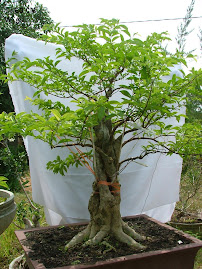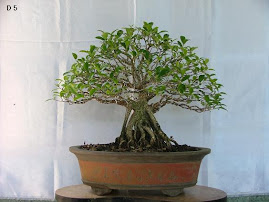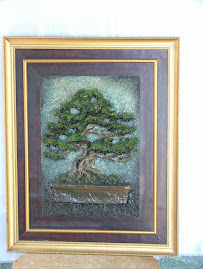Bonsai Features
A Close-Up on Indoor Tropical Bonsai in Northern ZonesBy Pauline F Muth
In the traditional sense of bonsai, there are no indoor bonsai.
Bonsai artists created their masterpieces from the local species that could remain outside year round in their climate. Modern houses generally are not suitable for the growth of bonsai. Yet people today want to grow their trees inside their homes; so specialized botanical knowledge that allows people to grow houseplants must be learned and modified to work with bonsai. If we remember that the first bonsai artists had to learn the special techniques that allow a tree to survive in a pot environment, we can treat growing bonsai indoors as a learning extension of existing bonsai horticulture.
In order to grow bonsai in our homes we need to overcome the following problems that are inherent with indoor conditions: * Lack of enough light intensity and duration for photosynthesis * Low humidity (this effects some species) that can be desert like * Insect infestations that occurs when household insects are treated to your fresh bonsai * Temperatures that are not compatible with the life cycles of certain species Indoor bonsai are those that are designed from trees or shrubs that are * not hardy in our climate and * must be protected from frost and freezing by being grown indoors in cold weather. (Under most circumstances it is too difficult to grow the bonsai from species that are hardy in our climate indoors. There are some special techniques that can make it possible. This will be discussed in a future Close-Up.) During frost-free months indoor bonsai should be grown outside on a table or stand. Most take full sun. Ask the merchant for the proper light conditions for your plant or research the conditions it needs.
Growing conditions for Indoor Bonsai
1. Light: Light is the energy that uses nutrients, water and air to produce life and growth. a. When indoors, give the bonsai as much light as possible [A southern, western or eastern window can work. A northern exposure is not enough light. Ideally you should provide artificial light (12-14 hours under plant lights)]. Turn the tree often for best growth. Each species of bonsai has its own light requirements…ask about this when purchasing the bonsai or research their needs in order to grow them best. b. Lack of light is the critical limiting factor when it comes to growing tropical or semi-tropical trees indoors. Even if you have a greenhouse, you will need to provide additional light in fall and winter until the days get long enough to supply sufficient light energy. If you are growing your bonsai in a southern window, add in artificial light to supplement the natural light. c. There are a few species that can exist in the southern light of fall and winter and will survive until summer. Ficus and Carissa are two of these. It must be noted however that the internodal spacing of new growth will be longer than you would like and the leaf color may not be as green as in summer. d. Flowering species require the most light especially if you want blooms. e. Bonsai do well in artificial light gardens. Growing under various types of artificial lights allows you full control over the bonsai's environment. Choose wide spectrum fluorescent lights. Grow the plants close to the light. Adjust the distance based on the plants reaction in your environment. f. Measure light with a light meter and set up conditions that match the known requirements of the bonsai tree.
2. Air and Humidity: When the bonsai are outside in the northeast humidity is not a problem. Our often desert dry interiors increases the transpiration rate of plants and dries them out too quickly. In order to keep this under control, we must provide additional humidity. We can also adjust the type of tree or shrub we use. Plants with thicker leaves can tolerate lower levels of humidity that those with thin leaves. The ideal humidity for indoor bonsai is 40% to 50%. Check with a humidity meter (hydrometer) or use the wet blue jeans test. Hang a pair of washed blue jeans in the area you wish to grow your bonsai in the evening. If the jeans are dry by morning, the humidity is too low. There are several methods you can use to raise humidity in your growing area of your house. a. You can use a humidifier in the house to bring up the humidity for your bonsai and for your health too. The cool mist type works well. b. Place glasses or cups of water around your bonsai. As the water evaporates, the humidity rises. c. Place trays of water under your bonsai. Remember to place the bonsai on tiles to keep the roots out of water. d. Unless you have forced air heat, you may wish to add a small fan to improve air circulation around your bonsai.
3. Temperature This will depend on the type of indoor bonsai you wish to grow a. Tropical i. Grow in warm temperatures throughout the year ii. Inside they need 64-75 degree F daytime temperatures with 57 to 61 degree temperatures at night. iii. These need warm feet…that is their soil needs to be warm. This can be accomplished by soil heating pads used for seed germination or using house heating systems like radiators. b. Subtropical i. Those that grow naturally with warm summers and cool winter ii. Inside they like cool conditions from 41 to 59 degrees F and can go a bit lower at night. c. Semi Hardy i. These trees are boarder-line hardy in our climate. Follow temperatures for subtropicals but leave these outside in the fall until leaves have dropped before bringing indoors. ii. They can survive light frosts in fall before they are moved indoors. iii. Many of these trees can be treated as hardy bonsai.
4. Water a. Water them regularly (no softened water) with lukewarm water. Cold water reduces the plants ability to absorb nutrients. Let your full watering can stand overnight and the water will be at the proper temperature. Outside you may use a watering can with a fine rose or a garden hose equipped with a fine nozzle. Indoors, in your sink, water gently from the top daily. DO NOT soak established bonsai for watering. If you leave bonsai soaking in a tray with water you will develop root rot. You may water by immersion BUT do not soak them. b. NEVER allow the bonsai to dry out completely. Keep the soil slightly moist but not wet. c. To increase humidity place a few stones or small tiles in a tray of water and place the bonsai on these tiles. The tray should be larger than the total width and depth of the bonsai. Most indoor bonsai will need daily watering in the arid environments of our homes. d. Note: if the bonsai soil is too compacted or has glued on stones, the trees will not grow since the soil will not take in water…return the tree to the merchant if you just have purchased it. If the compaction is due to lack of repotting, do so. The ideal timing for repotting is discussed later.
5. Fertilizer and Other Nutrients a. Fertilize with organic pellets such as Bio Gold during the growing season. These pellets allow you to fertilize once each month and they fertilizer is slowly released as you water. Begin their use at the beginning of January and discontinue in September. b. In January or at repotting, treat the soil with a dose of micronutrients and a dose of chelated iron. Repeat the iron one month later. Spring for these trees starts in January if they have enough light. c. If the tree is a flowering species, add a dose of super-phosphate each month to promote flowering. Continue to fertilize through September. Allow the tree to rest from October through December.
6. Insect and Diseases Problems While the bonsai is indoors wash the plant in Ivory Liquid solution, Concern Soap or Safer Soap every 10 days to prevent insect problems. Remember to rinse the plant later with clear water. I have found that I only need to do this for 3 times in the fall and generally I do not have problems during the winter. When the bonsai is outside, insect problems are greatly reduced. You will note that my recommendations are natural rather than man made chemicals. I prefer to limit the species I grow rather than grow certain species that often have difficult to control problems. I will not add more harmful chemicals into Earth's environment. When you bring a new bonsai into your home environment, keep it separate and wash it a couple of time before putting it near your collection.
Specific problems that may occur include: a. Powdery Mildew: A fungus infection on the top of the leaves usually the result of a lack of air circulation combined with evening watering on the leaves. b. Downy Mildew: A grey covering on the underside of the leaves with yellow spots on the top of the leaves. Here again poor circulation and wet soil is at fault. This also occurs when humidity is too high. c. Chlorosis: When leaves are yellowish and veins remain green. This is an iron deficiency, Treat it with chelated Iron. In the long run it is advisable to treat your bonsai soil with iron as a regular routine rather than wait for problems to occur. d. Sooty Mold: This is a black mold of older plants and can result in an aphid infestation. Increase circulation and treat with a fungicide. Treat this early or you your bonsai will be killed. e. Root Rot: Results from wet soil. You must remove the rotted roots and change the soil. Revise your watering technique so that the soil does not remain so wet. Keep fertilizer to a minimum until you see a healthier plant. f. Aphids: You can often keep these at bay by showering them off. Place yellow sticky around the plants to attack the flying stage of this and other insects. g. Scales: Scratch off or use alcohol on a swab. h. Spider Mites: Keep mites from affecting your bonsai with a soap wash as previously described. Once you see the webs, your plants are in serious danger. Wash the plant once every 10days for 3 cycles to TRY to eliminate. A miticide may be needed i. Whiteflies: Again use the yellow sticky cards and wash with soap. j. Mealy Bugs: Use alcohol on a swab.
7. Trimming Use normal bonsai trimming techniques. Remember that "Spring" for indoor bonsai begins December 22 as the length of daylight begins its yearly lengthening. Do not allow the tree to get out of control in January and February when they will go through a period of rapid growth. At this time the length and intensity of light is critical if you do not want long internodal spaced.
8. Repotting Repot tropical trees in mid summer during their dormant period or in early winter before new growth starts. Subtropicals and Semi hardy bonsai should be repotted in winter when grown indoors. This is at the end of December or early January. Repotting involves changing the soil and trimming the roots so that new fine roots may grow. Soil breaks down in time and needs replaced. Signs of the need to report include water not be absorbed and roots that fill the pot (lift the tree and look). When you repot, add iron, micronutrients, mycrorhyza and Bio Gold to the bottom layer of soil. You can trim MOST root systems back by 1/3 at repotting time. Be sure to put mesh over the pot holes and wire the bonsai into the pot. After repotting, you will soak the bonsai in a solution of water and transplanting solution.
Some indoor bonsai may be kept indoors year round IF provided with plenty of light, higher than normal household humidity and regular watering and fertilizer. They will benefit greatly from being placed outdoors in frost-free weather. When making the transition form indoors to outdoors you must be careful to prevent leaf burn. For some species you can defoliate before moving the tree outdoors. For other species you will need to slowly acclimate the bonsai by moving it into a shady area first before gradually moving it to full sun. Growing bonsai indoors is an adventure in learning. Start with one or two of the easier species and achieve success with them before moving on. Start with small sized bonsai, as the light requirements for them are more achievable than larger species.
What Species Make Good Indoor Bonsai?
Characteristics of trees that make good indoor bonsai: * Life cycles that do not require temperature fluctuations…temperature and seasonal changes in their natural environment are minimal * Their natural climate is similar to that of our home's interior. * They exhibit the normal traits of good bonsai…e.g. adapt to pot environments, small leaf size, good branching.
Some Species that have been grown for bonsai indoors
Difficulty
Lumens
Temp Range
Adenium obesum
Desert rose
easy
1000
Subtropical
Bougainvillea glabra
easy
2000
Subtropical
Bucida spinosa
Black olive
moderate
1500
Tropical
Buxus
Boxwood
moderate
800
Semi Hardy
Carissa macrocarpa-grandiflora
Natal plum
easy
900
Subtropical
Calliandra hamematocephala
Powderpuff
difficult
2000
Subtropical
Camellia japonica
moderate
1000
Subtropical
Carmona microphylla
Fukien tea
difficult
1000
Tropical
Cuphea hyssopifolia
False heather
moderate
1000
Tropical
Cotoneaster
easy
1500
Semi Hardy/Hardy
Eugenia mytrifolia
Bush cherry
easy
1500
Tropical
Ficus
fig
easy
800-2000
Subtropical/Tropical
Fuchsia
moderate
800
Subtropical
Gardenia
moderate
1000
Subtropical
Grewia
Star flower
moderate
1500
Subtropical
Hedera
Ivy
easy
800
Semi Hardy/Hardy
Lantana
moderate
2000
Subtropical
Malpighia coccigera
moderate
1500
Tropical
Murraya paniculata
Orange jasmine
moderate
1000
Tropical
Myrciaria cauliflora
Jaboticaba
moderate
1500
Tropical
Myrtus communis
Myrtle
moderate
1000
Semi Tropical
Olea
Olive
easy
1000
Subtropical
Pelargonium
Geranium
easy
1000
Subtropical
Punica granatum Nana
Pomegranate
moderate
1500
Subtropical
Pyracantha
Firethorn
moderate
1000
Semi Hardy/Hardy
Rosmarinus officinalis
Rosemary
moderate
1000
Subtropical
Sageretia theezans
difficult
1000
Subtropical
Serissa foetida
moderate
1000
Tropical
Ulmus parvifolia
Chinese elm
easy
1000
Semi Hardy
There are many others species that can be used for indoor bonsai. Experiment.
Please be advised that the above information is the result of my experiences with my specific horticultural habits in my climate and may not work as well for you. Experiment with a few bonsai at first and modify based on your experiences.
All in all, unless you are willing to construct a good growing environment and get you bonsai outside for the frost free months, get a greenhouse for indoor bonsai and even then you will need to supplement the light for many species.
Subscribe to:
Post Comments (Atom)























1 comment:
Hi Dude,
Nice post! Indoor bonsai are bonsai which are cultivated for the indoor environment. Thank you...
Post a Comment